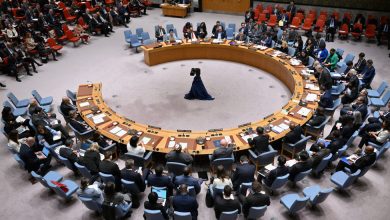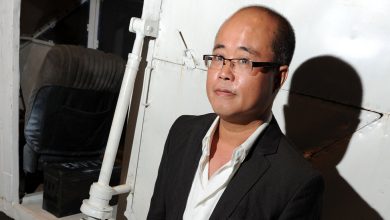Ravaged Israeli Border Community Ponders: What’s Next?

The kibbutz’s pub looks much as it always has. Trophies won by the communal village’s soccer team, the Kfar Aza Foxes, line a shelf above the bar. Residents, young and old, gather to swap news, share a drink or play a game of pool.
It is the sort of scene that has played out for decades in Kfar Aza, a pastoral cooperative established nearly 70 years ago along the border with Gaza.
Despite the familiar trappings, nothing is the same.
Not the pub — a facsimile of the real thing, lovingly recreated by displaced community members off the lobby of a hotel hours away from their devastated village. And not the people — whose homes were destroyed and whose families were torn apart by killing and kidnapping.
Once a lush communal farm surrounded by sunflower fields, Kfar Aza, among the hardest hit communities in the Hamas-led attacks of Oct. 7, is now blackened and scarred. The terrorists who stormed the kibbutz that day went house to house for hours, methodically murdering more than 60 people, including grandparents and children. They abducted 19 others, according to community members and the authorities.
Seven men and women from the kibbutz are still being held hostage in Gaza. Their absence is as palpable as their fates are unknown. Of those who returned to Israel last month, after more than 50 days of captivity, some learned their family members had been killed in the assault, others learned that loved ones were still being held hostage and they all learned they could not go back to their homes.

Israeli soldiers surveying destroyed homes in Kfar Aza last month.
Of Kfar Aza’s 900 residents who managed to escape on Oct. 7, about half are now living at the hotel in Shfayim, a kibbutz north of Tel Aviv, because their homes lie in ruins. Other residents are being similarly housed at the government’s expense in rentals or at other hotels along the Mediterranean coast.
On a recent visit to the hotel, there were signs that the kibbutzniks were trying to create a semblance of their old lives. But like the rest of Israel, they are questioning if it is possible to restore what was lost.
“The idea of home is a very powerful one,” said Ori Epstein, 53, Kfar Aza’s agricultural and business manager, who is among those staying in the hotel. “But it’s too early to know” about going back, he said.
The communities along the Gaza border bore much of the brunt of the Oct. 7 attack, and now they bear the weight of the country’s grief. The decisions they make now — about how to rebuild, how to remember, whom to blame and whom to forgive — will resonate nationwide.
For many families, chief among those decisions is whether to return at all to the area along the Gaza border. Many Kfar Aza residents feel betrayed by the government, which they say did not do enough to protect them. Others worry about the outcome of the war in Gaza and whether the border will ever be safe again.
But some residents view the prospect of rebuilding as a referendum on resilience and as a sign of the country’s long-term survival.
“If we don’t go back to Kfar Aza, Ashkelon and Ashdod will be next,” said Naomi Hershfeld, 51, referring to the coastal cities north of the Gaza Strip as potential targets for Hamas. “Then they’ll conquer Tel Aviv.”
“If we don’t go back there, there’ll be no state,” she added, echoing a common sentiment across a country that has suddenly shrunk within its borders.
Overall, nearly half of Kfar Aza’s homes were damaged or destroyed on Oct. 7, and the authorities say it could take two years to rebuild. The young adults’ quarter, where the 20- to 30-year-olds lived in rows of small apartments, is a charred monument to the tragedy. Some people talk about preserving the burned ruins as a memorial.
The main challenge, said Victor Weinberger, a lawyer who has taken charge of the effort to raise funds and plan the kibbutz’s rehabilitation, is how to keep the community together.
The hotel in Shfayim is likely to be home for another six months, then the kibbutzniks are likely to move into mobile homes, Mr. Weinberger said. He and a team of volunteers are also working to develop a program around social and psychological healing, which he says will take much longer than physically rebuilding the kibbutz.
For now, the kibbutzniks — nature-loving farmers, hardy pragmatists and idealists — are doing what they can to reestablish the rhythms of their old lives, sharing meals together in the hotel’s dining room and recreating the community pub.
One day in November, children and dogs ran around in the hotel lobby. And a row of constantly whirring washing machines outside lent the hotel a semblance of normalcy — among the crying and the mourning.
“We lost our son. We lost our home,” said Shai Hermesh, 79, a former farmer and legislator, whose son Omer, 48, was killed on Oct. 7. “The kibbutz is destroyed, and at nearly 80 I have to build my life anew.”
Like many in Israel, the kibbutz members relive their Oct. 7 experiences again and again. Mr. Hermesh, a veteran of Israel’s most consequential past wars, said he and his wife, Hava, 75, waited more than 30 hours before the military rescued them on Oct. 8, leading them on a mile-long “death march” as gun battles raged around them.
The scale of the loss for many residents is staggering.
Mr. Epstein lost a son, Neta, 22, on Oct. 7 as well as his mother, Bilha, 81, two brothers-in-law and a nephew. Neta threw himself on a grenade to save his girlfriend. One brother-in-law, Ofir Libstein, 50, who was killed while defending the kibbutz, was a regional council head known nationally for his efforts to improve the lives of his Palestinian neighbors in Gaza.
Liran Zadikevitch, 26, a student of civil engineering who lost his father on Oct. 7, said his peers’ plans to return to Kfar Aza after university and live out their lives together had been dashed. One of his friends is dead and four others are thought to be still in Gaza.
Kfar Aza had something to celebrate on Nov. 26 when 11 hostages from the kibbutz, including women, children and a Thai worker, were released from Gaza under a deal that included a pause in the fighting and the exchange of Palestinian prisoners. Another woman was released days later.
The absence of those who remain in Gaza is keenly felt by the community. A special kinship has formed between the families of the returned hostages and those still in captivity.
“Every minute we are thinking of the hostages left behind,” said Avichai Brodutch, a farmer and nursing student from Kfar Aza whose wife and three children spent more than 50 days in Gaza before their release last month. “We are broken by it and swear to keep struggling till they are back,” he added.
On a recent afternoon, Galgalatz, a popular radio station run by the military, brought Idan Raichel, a famous pop singer, to perform a show live from the ersatz pub that the kibbutzniks had built in the hotel lobby.
Young kibbutz members dedicated ballads to loved ones who had been kidnapped or killed. The audience kept dissolving in tears.
Among the remaining hostages from Kfar Aza is Alon Shamriz, 26. His brothers, Yonatan, 33, and Ido, 32, were the driving forces behind replicating the pub at Shfayim — to have it ready for Alon’s return, Ido said.
The brothers did everything together, he said, including running a small family factory that produces wood pallets and crates.
“We don’t know if he is OK, if he sees daylight,” Alon, who fought to defend Kfar Aza in the early hours of the attack, said of his brother.
“Everyone who comes back to us is a miracle,” he said. “But,” he added, “I don’t want him to be left behind.”



